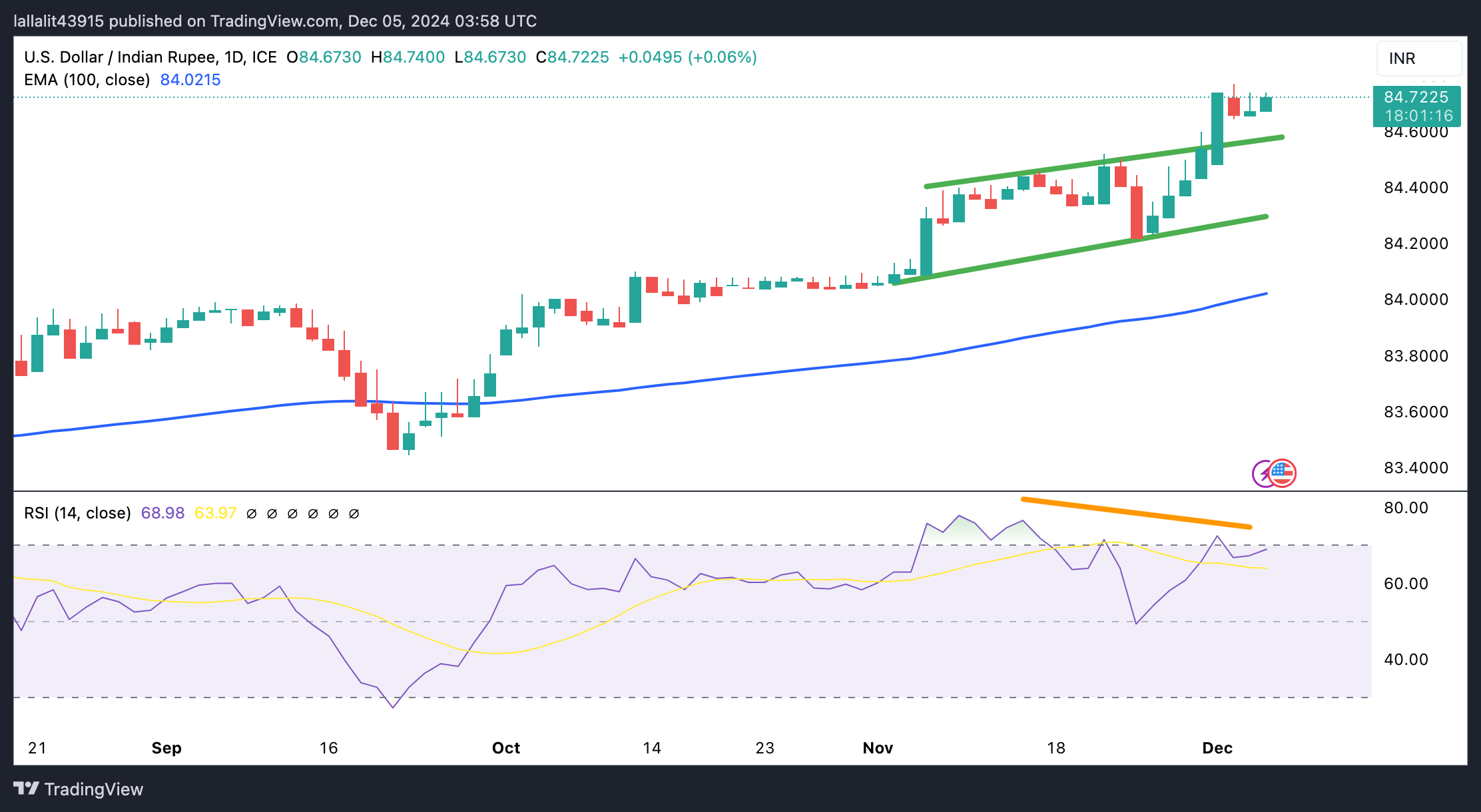USD/INR extends the rally on worries over Indian economic growth

- The Indian Rupee drifts lower in Thursday’s early European session.
- Disappointing Indian economic data, portfolio outflows and a firmer USD undermine the INR.
- Investors await US weekly Initial Jobless Claims and Goods Trade Balance releases later on Thursday.
The Indian Rupee (INR) remains weak near a record low on Thursday despite interventions by the Reserve Bank of India (RBI). The strong US Dollar (USD) demand, worries over India’s economic growth and significant outflows from Indian portfolios following Donald Trump’s strength in the US Presidential elections exert some selling pressure on the INR.
Nonetheless, the lower crude oil prices could help limit the local currency’s losses as India is the world’s third-largest oil consumer. Investors will monitor the US weekly Initial Jobless Claims and Goods Trade Balance reports, which will be published later on Thursday. On Friday, all eyes will be on the RBI interest rate decision and the highly anticipated Nonfarm Payrolls (NFP) data.
Indian Rupee softens amid new all-time lows
- The HSBC India Services PMI arrived at 58.4 in November versus 59.2 in October. This reading came in below the market consensus of 59.5.
- “The hiring surge reflected the sector’s improving business confidence, growing new orders, and vigorous international demand,” noted Pranjul Bhandari, chief India economist at HSBC.
- US service sector growth slowed by more than expected in November, falling to 52.1 from 56.0 in October, according to the Institute for Supply Management (ISM) on Wednesday.
- The US S&P Global Composite PMI declined to 54.9 in November, compared to the previous reading and the expectation of 55.3. The Services PMI dropped to 56.1 in November versus 57.0 prior, below the consensus of 57.0.
- The Fed Chair Jerome Powell noted on Wednesday that the US economy is in remarkably good shape, allowing Fed officials to potentially be more cautious in cutting interest rates further. Powell added that Unemployment is still very low and the Fed made progress on inflation.
- According to the Fed’s Beige Book survey released on Wednesday, the US economic activity increased slightly in November after little change in preceding months, and US businesses grew more upbeat about demand prospects.
USD/INR’s positive picture prevails, but Bearish Divergence on RSI might cap its upside
The Indian Rupee edges lower on the day. The USD/INR pair maintains the uptrend on the daily timeframe, with the pair holding above the key 100-day Exponential Moving Average (EMA). However, further consolidation cannot be ruled out as the pair makes higher highs, but the 14-day Relative Strength Index (RSI) makes lower highs, indicating bearish divergence. This suggests that the trend is weakening and the upward direction might reverse in the near term.
The first resistance level to watch is near the all-time high of 84.77. Extended bullish candlesticks could pave the way to the 85.00 psychological mark, followed by 85.50.
On the flip side, any follow-through selling below the resistance-turned-support at 84.60 could expose 84.22, the low of November 25. The potential support level is seen at 84.02, the 100-day EMA.
RBI FAQs
The role of the Reserve Bank of India (RBI), in its own words, is “..to maintain price stability while keeping in mind the objective of growth.” This involves maintaining the inflation rate at a stable 4% level primarily using the tool of interest rates. The RBI also maintains the exchange rate at a level that will not cause excess volatility and problems for exporters and importers, since India’s economy is heavily reliant on foreign trade, especially Oil.
The RBI formally meets at six bi-monthly meetings a year to discuss its monetary policy and, if necessary, adjust interest rates. When inflation is too high (above its 4% target), the RBI will normally raise interest rates to deter borrowing and spending, which can support the Rupee (INR). If inflation falls too far below target, the RBI might cut rates to encourage more lending, which can be negative for INR.
Due to the importance of trade to the economy, the Reserve Bank of India (RBI) actively intervenes in FX markets to maintain the exchange rate within a limited range. It does this to ensure Indian importers and exporters are not exposed to unnecessary currency risk during periods of FX volatility. The RBI buys and sells Rupees in the spot market at key levels, and uses derivatives to hedge its positions.
